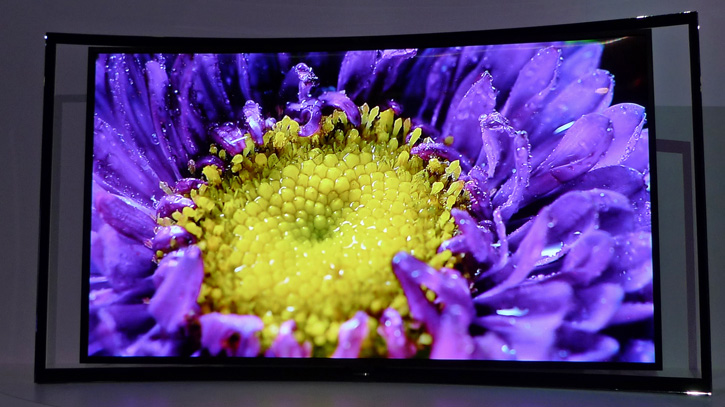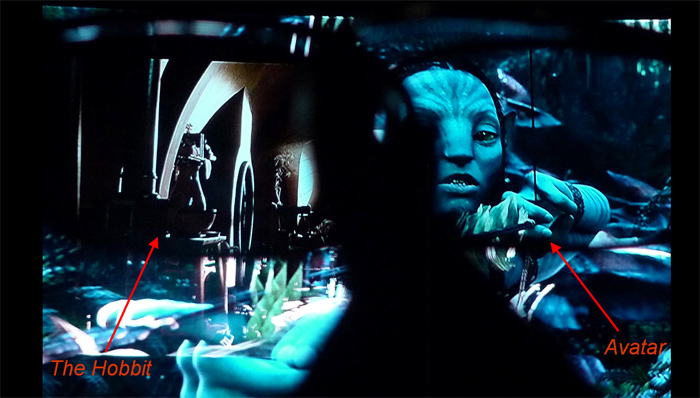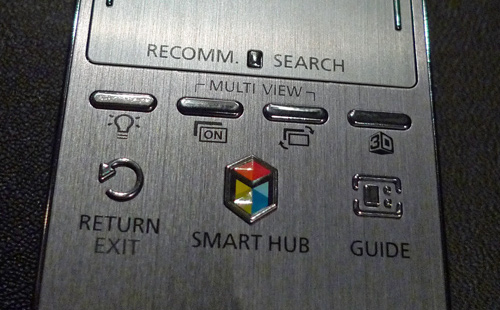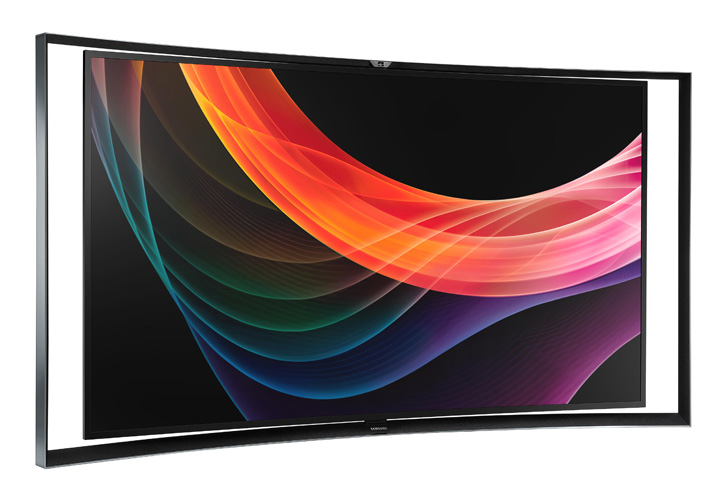It's Curvalicious!
Earlier this month, Samsung held a press event in New York City to unveil their new curved OLED TV. The 55-inch KN55S9C ($8,999.99, available now) wowed event attendees, including yours truly, but how would it hold up under closer scrutiny? I would find out a few days later as I visited Samsung's QA Labs in rural New Jersey to spend some quality time with the new set.
"It's Like, How Much More Black Could This Be? The Answer is None... None More Black"
-Nigel Tufnel, "Spinal Tap"
I'm happy to say that the positive impression Samsung's OLED TV made on me first at CES 2012, and in its curved form at CES 2013 and again at the press event held up quite well in an in-depth evaluation. In addition to viewing a few test patterns, like a 0 IRE black field (which redefined the term "black level") and cross hatch patterns, I settled in with some sushi (and Kim-Chee, of course) and a few good movies to see what this puppy could do.

First up was "Blade Runner: The Final Cut" (on Blu-ray, natch). The opening credits on this film will make most LED/LCD TVs (and even a few plasmas) run screaming from the room. Producing a deep black is one thing, but trying to do so - maintaining that deep dark black level - when there is white text scrolling up the screen can bring out the flaws in otherwise-capable sets. LED/LCD sets sometimes exhibit ghosting or ringing around the edges of white images on a dark background, visible problems with the set's lighting uniformity or unnatural motion on the scrolling text. Plasma sets can show their limits when the bright white text appears slightly grey against that deep black background. Samsung's OLED set showed no such limitations, producing clean white, smoothly scrolling text on a pitch black background. The human (or is it?) eye that fills the screen shortly after the introduction was captured in gorgeous detail.
Moving onto "The Avengers," the set continued to impress. The glowing blue tesseract practically leapt off the screen, while subtle facial details evident in Hawkeye's transformation from free agent to Loki-loving lunatic were revealed in all their tortured glory. In "Skyfall," fast action scenes such as the opening car chase and careening tube train were represented cleanly without excessive motion smearing. In short, the Samsung OLED set was almost 3D in its presentation of moving images, without the need for glasses.
But for those who like "real" 3D (both of you), this set has got that as well, in the "active shutter" variation. I donned Samsung's active 3D glasses and viewed a few Blu-ray 3D titles. As expected, native 3D movies were presented with rich detail and minimal crosstalk. For fun, I put on both "Avatar" and "The Hobbit: An Unexpected Journey" in full HD 3D, both at the same time. What? You heard me. Two 3D movies can be displayed by the KN55S9C at the same time.

I fed the set with both films via two separate Blu-ray 3D players connected to different HDMI ports and activated the set's new "Multi-view" feature which displays two different sources on screen concurrently. Watching this mode without 3D glasses on was an exercise in extreme multi-tasking, but once you put on (and synch) the glasses, you can choose between the two active sources for your viewing pleasure with a simple push of a button. Earbuds built into the glasses ensure that the sound matches the picture. And if 3D is not your thing, either one or both of the signals can be a standard 2D source as well.
Personally, I feel that this multi-view feature is a bit of a gimmick. How many households will really want to watch two movies or TV shows on the same TV at the same time? It's not conducive to actual interaction (giggles from the kids watching "Shrek" on input A while the parents are watching "Schindler's List" on input B might be a little unsettling). Also, the feature, as tested, doesn't really work very well. Not only is the picture fairly dark, but there is a noticeable amount of bleed or crosstalk between the two images, particularly when one is displaying a dark scene and the other one a bright scene.
When I asked one of the OLED TV engineers about the crosstalk, he said the LCD glasses are not fast enough to keep up with the OLED panel. To display these two concurrent 3D moving images, the set is running at at least 240 Hz (240 frames per second), and apparently the LCD shutters in the glasses are not quite up to the task. Also, at least as far as I could tell, picture controls are not accessible in multi-view mode - they are all greyed out. Granted, this is something that could be addressed in a future firmware upgrade, but access to brightness, contrast and color controls in multi-view mode would be nice. For now, Multi-view is a cool party trick, but not much more than that.

All This and Brains Too
Of course, the set features Samsung's 2013 Smart TV suite of apps and advanced controls (voice control, gesture control, and a slightly modified touch pad remote as well as a standard button-based remote). The new "On TV" feature, which recommends what to watch based on your own preferences and social media analytics, is here, along with a huge selection of streaming apps and widgets. There's even a full web browser on board. There's a built-in HD camera for Skype and facial recognition, but don't worry about the set spying on you as you can easily move the camera out of sight (and yourself out of the camera's view) with a simple slide of a plastic tab at the top of the screen. They call this the "Gary switch" though I'm quite sure I have no idea why (inside joke).
A Few Words on The Curve
One thing that strikes the eye about the set is its subtle concave screen curvature. Rather than present a standard flat screen as you'd see on a plasma or LCD set, the KN55S9C curves slightly inward in the center. Samsung says that this gives the viewer a more enveloping or cinematic view. And while that may be true of large screens (e.g., movie cinema screens), the curve does little to enhance the immersiveness of the picture on a 55-inch screen. More likely Samsung gave their first OLED TV a curved screen so it would stand out as different from everything else out there (well, except LG's OLED TV, which is also curved). Crosshatch test patterns still appeared with proper geometry so I would say that while the curve does not really enhance the image, it also does not significantly detract from it.

The Bottom Line
Nit picks about screen curvature and multi-view aside, in the areas that matter: black level reproduction, contrast, lighting uniformity, and color saturation, Samsung's KN55S9C shines like no other set we've seen. Highly recommended.